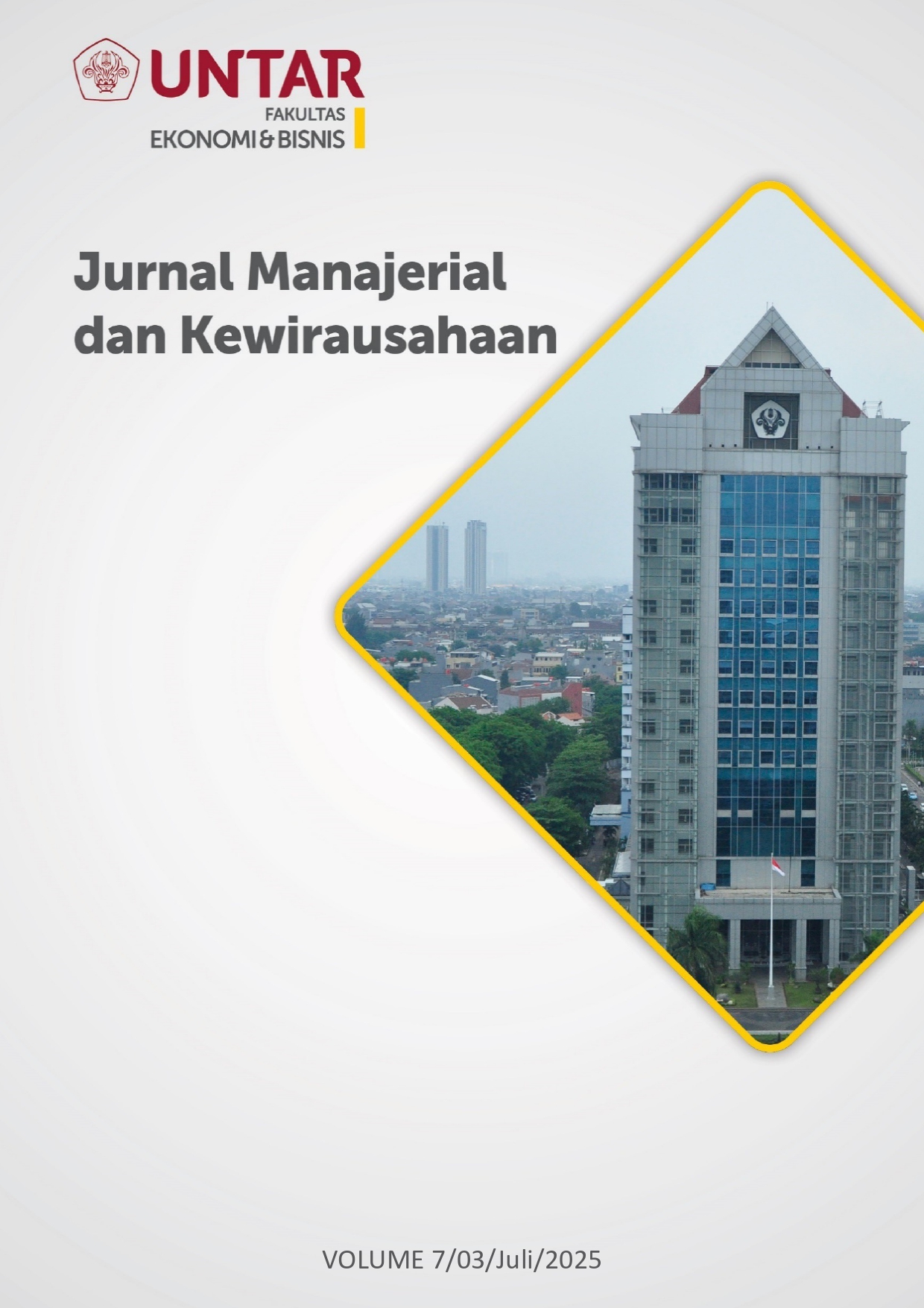Pengaruh Kepemimpinan Inspiratif, Komunikasi Efektif, dan Pelatihan Terarah terhadap Kinerja Karyawan pada UMKM Ritel Mandiri di Bandar Lampung
Main Article Content
Abstract
Penelitian ini membahas pengaruh kepemimpinan, komunikasi, dan pelatihan terhadap kinerja karyawan pada UMKM ritel mandiri di Bandar Lampung, yang memiliki peran penting dalam perekonomian lokal. Metode yang digunakan adalah kuantitatif dengan survei terhadap 110 responden, yaitu karyawan sektor ritel. Kuesioner yang disebarkan meliputi pertanyaan tentang kepemimpinan, komunikasi, pelatihan, dan kinerja. Data dianalisis menggunakan Structural Equation Modeling (SEM) dengan perangkat lunak SmartPLS. Hasil analisis menunjukkan bahwa kepemimpinan inspiratif dan pelatihan terarah berpengaruh positif dan signifikan terhadap kinerja karyawan, sedangkan komunikasi efektif tidak menunjukkan pengaruh signifikan. Koefisien determinasi (R²) untuk kinerja karyawan adalah 0,455, mengindikasikan bahwa 45,5% variasi kinerja dijelaskan oleh ketiga variabel independen. Uji hipotesis menunjukkan kepemimpinan inspiratif dengan t-statistik 2,317 dan p-value 0,021, serta pelatihan terarah dengan t-statistik 3,663 dan p-value 0,000, menunjukkan signifikansi. Sebaliknya, komunikasi efektif memiliki t-statistik 0,648 dan p-value 0,517, yang berarti tidak signifikan. Kesimpulannya, penguatan gaya kepemimpinan yang inspiratif dan program pelatihan terarah sangat penting untuk meningkatkan kinerja karyawan UMKM ritel di Bandar Lampung. Selanjutnya, direkomendasikan agar manajemen UMKM terus meningkatkan kualitas kepemimpinan dan pelatihan guna meningkatkan daya saing di pasar. Penelitian ini diharapkan berkontribusi terhadap pengembangan strategi manajemen sumber daya manusia di sektor UMKM.
This study examines the influence of leadership, communication, and training on employee performance within independent retail SMEs in Bandar Lampung, which play a crucial role in the local economy. A quantitative method using a survey was employed to collect data from 110 respondents, who are employees in the retail sector. The distributed questionnaire included questions regarding leadership, communication, training, and performance. Data were analyzed using Structural Equation Modeling (SEM) with SmartPLS software. The results indicate that inspirational leadership and targeted training have a positive and significant impact on employee performance, whereas effective communication showed no significant effect. The coefficient of determination (R²) for employee performance was found to be 0.455, meaning that 45.5% of the performance variation can be explained by the three independent variables. Hypothesis testing revealed that inspirational leadership had a t-statistic of 2.317 with a p-value of 0.021, while targeted training had a t-statistic of 3.663 with a p-value of 0.000, indicating significance. In contrast, effective communication had a t-statistic of 0.648 and a p-value of 0.517, suggesting it was not significant. The conclusion emphasizes the importance of strengthening inspirational leadership and targeted training programs to enhance employee performance in retail SMEs in Bandar Lampung. Moreover, it is recommended that SME management continually improve leadership quality and relevant training to maintain competitiveness in the market. This study is expected to contribute to the development of human resource management strategies within the SME sector.
Article Details

This work is licensed under a Creative Commons Attribution-NonCommercial-ShareAlike 4.0 International License.
This work is licensed under a Jurnal Muara Ilmu Ekonomi dan Bisnis Creative Commons Attribution-ShareAlike 4.0 International License.,/p>
References
Agustine, M. T., & Edalmen. (2020). Pengaruh gaya kepemimpinan, disiplin kerja, dan motivasi kerja terhadap kinerja karyawan PT. Limas Surya Makmur. Jurnal Manajerial dan Kewirausahaan, 2(1), 62-70. https://doi.org/10.24912/jmk.v2i1.7425
Bass, B. M., & Riggio, R. E. (2006). Transformational leadership, 2nd edition. Lawrence Erlbaum Associates.
Blume, B. D., Ford, J. K., Baldwin, T. T., & Huang, S. (2010). Transfer of training: a meta-analytic review. Journal of Management, 36(4), 1065-1105. http://dx.doi.org/10.1177/0149206309352880
De Vries, M. F. R. K. (2002). The Leadership of Change: A Communication Perspective. Leadership & Organization Development Journal, 23(4), 203-211.
Febbyani, A., & Masman, R. R. (2019). Pengaruh gaya kepemimpinan, kompensasi, dan lingkungan kerja terhadap kinerja karyawan pada PT. Apatel. Jurnal Manajerial dan Kewirausahaan, 1(4), 725-735. https://doi.org/10.24912/jmk.v1i4.6551
Judge, T. A., & Robbins, S. P. (2017). Essentials of organizational behavior. Pearson Education.
Mgbere, O. (2009). Exploring the relationship between organizational culture, leadership styles and corporate performance: an overview. Journal of Strategic Management Education, 5(3/4), 187-201.
Miller, K. (2005). Organizational Communication: Approaches and Processes (3rd ed.). Boston: Houghton Mifflin.
Noe, R. A. (2017). Employee Training and Development (7th ed.). McGraw-Hill Education.
Oladipo, A. A., & Oyediran, O. A. (2013). The effects of directed training on employees’ performance in Nigeria. International Journal of Research in Business and Social Science, 2(2), 43-56.
Salas, E., Tannenbaum, S. I., Kraiger, K., & Smith-Jentsch, K. A. (2012). The Science of Training and Development in Organizations: What Matters in Practice. Psychological Science in the Public Interest, 14(2), 74-101.
Williams, & Davis, (2020). The Impact of Technological Change on Employee Motivation and Performance. Journal of Organizational Change Management, 33(2), 1-15.



